By Angus Dalton
Examine, a free weekly newsletter covering science with a sceptical, evidence-based eye, is sent every Tuesday. You’re reading an excerpt – sign up to get the whole newsletter in your inbox.
There was a reason biologist Jay Storz braved 21 volcano summits in two years, battling bouts of altitude sickness and fissures belching sulfuric fumes.
That reason lay nestled next to a pile of rocks at the 6000 metre-high summit of Volcan Salin, a mountain on the Argentina-Chile border – a mummified mouse.
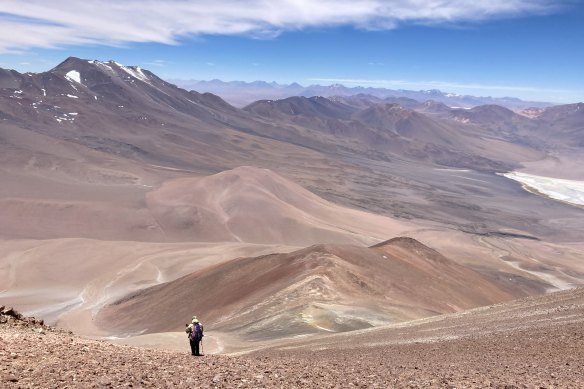
The Mars-like flanks of Volcán Salín in northern Chile, which researchers scoured for signs of life.Credit: Mario Pérez Mamani
For years Storz, an expert in high-altitude biology from the University of Nebraska, had chased evidence that mice live on the cloud-splitting peaks of South America’s mountains, thousands of metres above what was considered the altitude threshold for long-term mammalian life.
The freezing, dry, low-oxygen environment is one of the habitats on earth most similar to Mars, and the discovery of the mummified mouse – reported in Current Biology – has redefined our understanding of the physiological limits of mammals.
So what can we learn from these mummified mice about our search for life on Mars?
Record-breaking rodents
After stumbling upon their first mouse mummy, Storz and a colleague started searching through a nearby rock pile and uncovered seven more cadavers.
They found another five mice – mummified by the thin atmosphere and extreme cold – while trekking to other volcano summits across the Andes.
There was a chance the mice were ferried to those heights by the ancient Incas, who once performed ceremonial sacrifices on the peaks.
But radiocarbon dating revealed the oldest mouse mummy was 350 years old, and many had died only in the past few decades.
Researchers set traps and captured live specimens, proving populations of Punta de Vacas leaf-eared mice roam more than 6700 metres above sea level. Previously, anything higher than 5200 metres was considered a mammalian no-go zone.
“Well-trained mountain climbers can tolerate such extreme elevations during a one-day summit attempt, but the fact that mice are actually living at such elevations demonstrates that we have underestimated the physiological tolerances of small mammals,” Storz said.
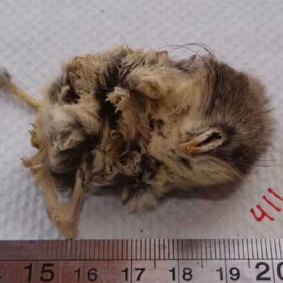
A mummified mouse, retrieved from the summit of a South American volcano.Credit: MARCIAL QUIROGA-CARMONA
“The most surprising thing about our discovery is that mammals could be living on the summits of volcanoes in such an inhospitable, Mars-like environment.”
Extremophiles and the search for alien life
Creatures that thrive in toxic, acidic, radioactive, anaerobic, searing hot or deadly cold habitats – called extremophiles – rewrite biologists’ understanding of life on earth and the sheer force of evolution. But another group of researchers pay attention, too: astrobiologists.
These scientists scrutinise how life may have sprung up on Earth and where it could be lurking elsewhere in the universe.
“You might classify these mice as a type of extremophile,” says Dr Albert Fahrenbach. He’s the director of UNSW’s Australian Centre for Astrobiology, the only centre of its kind in the country.
Fahrenbach’s colleagues have scoured the globe for the most alien environments to help them deduce what we might find on seemingly barren exoplanets.
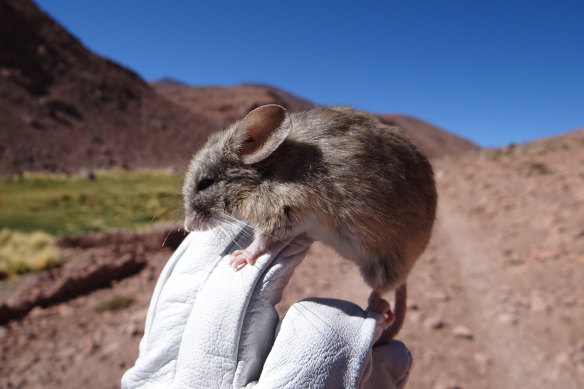
Extremophiles are usually bacteria, but you could say the leaf-eared mouse – found far above the normal mammalian altitude threshold – has joined the ranks of microbes that live in permafrost and radioactive waste.Credit: Marcial Quiroga-Carmona
For example, the centre’s Professor Belinda Ferrari discovered bacteria in the soil of hyper-arid deserts in Antarctica, where there’s little available water or organic carbon, and the sun can vanish for months, precluding photosynthesis.
The bacteria were consuming hydrogen, carbon dioxide and carbon monoxide, generating energy and water to stay alive – essentially, living off thin air. Their discovery provided a new model for how bacteria might thrive on harsh alien planets, nourished only by the atmosphere.
Each time scientists discover an extremophile – from the high-altitude mice to air-eating bacteria – our limited ideas about what life might look like beyond Earth expands, boosting our chances of recognising habitats on other planets that may sustain alien organisms.
The Australian mission to find Martians
In June, another of the centre’s astrobiologists, Professor Martin Van Kranendonk, led NASA personnel through the red dust of the Pilbara in the north of Western Australia to show them stromatolite fossils.
These swirls of dark silica, produced by prehistoric cyanobacteria, date back 2.7 billion to 3.5 billion years – the oldest confirmed evidence of life on Earth.
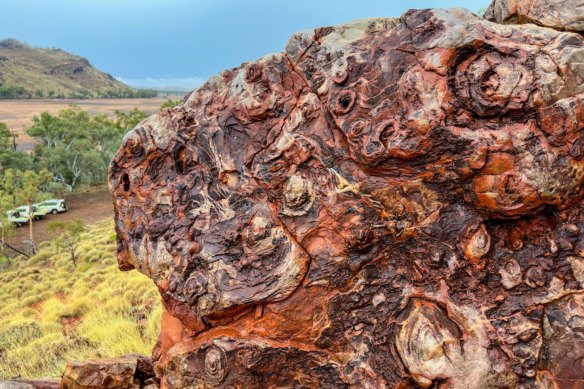
Astrobiologists surveyed structures in WA, including these “egg carton” stromatolites, to refine their search for evidence of microbes on Mars. Credit: NASA/Mike Toillionu
In 2007, the Spirit rover stumbled across similar silica structures in the Columbia Hills of Gusev crater on Mars, Fahrenbach says.
In particular, the structures resembled microbe-produced silica deposits found at the edge of the Atacama Desert in Chile – another landscape used as a proxy for Mars that isn’t far from Storz’s mummified mice.
“To the untrained eye, they just look like some unusual rock,” says Fahrenbach. “They have these really crazy textures, but from a geologist’s point of view, they’re pretty easy to identify as arising from life.”
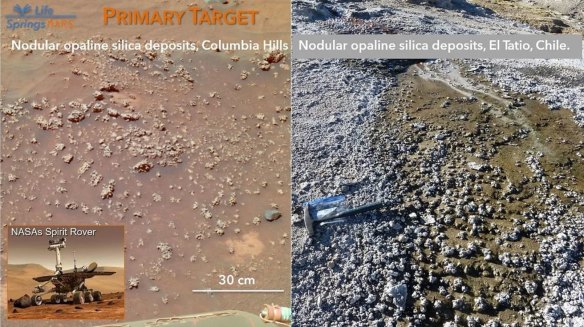
Silica deposits found on Mars in 2007 compared with silica deposits in Chile, which were shaped by microbes.Credit: LifeSprings Mars
The Martian structures, too, could yield biosignatures – evidence of creatures once alive on the dusty red planet.
“There’s only one way to be sure – to bring a sample back and study it on Earth, to see if we can provide evidence that these structures were generated biologically, ” says Fahrenbach.
The LifeSprings Mars mission, led by Van Kranendonk, aims to retrieve that all-important Martian sample for testing. According to the researchers behind the mission, it’s “humanity’s best chance to search for extraterrestrial life”.
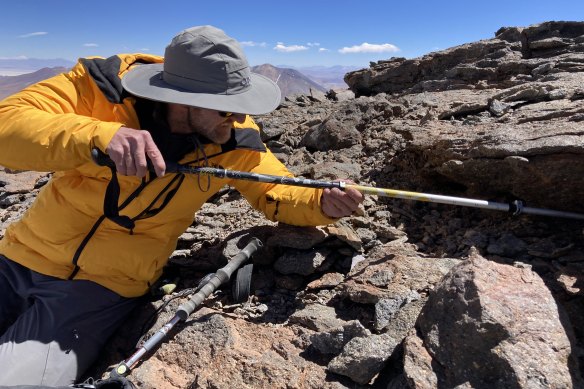
Biologist Jay Storz on Chile’s Volcan Pular where mouse mummies were excavated.Credit: Mario Pérez Mamani
But even as our knowledge of earthbound biology expands, there’s always the chance alien life is so beyond our current imagination we’re looking in the entirely wrong places, Fahrenbach says.
“There could be life out there that’s not based on any chemistry that we recognise.”
The Examine newsletter explains and analyses science with a rigorous focus on the evidence. Sign up to get it each week.